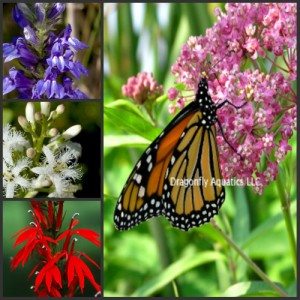I'm not certain of the identity of this butterfly. I thought perhaps it was a male Eastern Tiger Swallowtail. I'm really not certain, although it sure liked my dwarf crab-apple tree. It came back day after day.....I'm thinking it was the same one.
I know we don't want to think about it but it won't be long and fall will be here and we all know what comes next.....its time for us to be thinking about taking the extra care with our pond plants to make them comfortable for the winter cold. I've noticed the butterflies aren't as plentiful as they had been but occassionally I'm able to catch one.
HARDY BOG/MARGINAL PLANTS
Once your hardy marginal plants begin to brown, usually after the first hard frost, prune back excess foliage and discard any decaying material, so it does not compromise the water quality over the winter months. Potted bog plants such as Pickeral, Thalia Dealbata, and Japanese Variegated Iris should be placed at a sufficient depth to avoid freezing the crown of the plant. Most of the other hardy bog plants can be left as they are and will return the following spring.
Tropical Bog Plants
Many of the tropical bog plants will winter well indoors in a sunny window or with a grow light. They do not need to be submerged in water. Keep the soil constantly moist by placing the potted plants in a tray of water.
 I've been wanting to write something on this subject for some time now. Finally, I have a bit of time to address the subject of water depth for bog plants and marginal plants. Simply put, bog plants like their "feet" wet. Translation....roots and soil moist at all times. When the plants are first planted, this is especially important. Many of the bog plants will take deeper water as they mature and spread. But, when you first receive your bog plants, you will have better success if you place them where there is no more than a half inch or less of water above the soil line. Think of the marshes and swampy areas, you have passed while traveling down the road. These natural reservoirs, fill during the rainy season and will dry out during dry spells. The plants adjust to the varying water depth and grow and spread rapidly. If you have a question on a particular plant, just ask and we will be happy to help you plant and grow beautiful marginal and bog plants.
I've been wanting to write something on this subject for some time now. Finally, I have a bit of time to address the subject of water depth for bog plants and marginal plants. Simply put, bog plants like their "feet" wet. Translation....roots and soil moist at all times. When the plants are first planted, this is especially important. Many of the bog plants will take deeper water as they mature and spread. But, when you first receive your bog plants, you will have better success if you place them where there is no more than a half inch or less of water above the soil line. Think of the marshes and swampy areas, you have passed while traveling down the road. These natural reservoirs, fill during the rainy season and will dry out during dry spells. The plants adjust to the varying water depth and grow and spread rapidly. If you have a question on a particular plant, just ask and we will be happy to help you plant and grow beautiful marginal and bog plants.
 The Chameleon Hardy Bog Plant is a variegated interesting plant. The foliage is fragrant and single, small white flowers appear on it in the summer. They look like single petaled roses. The heart shaped leaves turn in the fall, as the weather turns cooler, into a dark maroon-purple color which is very striking. It is a very rampant runner in moist soil, which it prefers, and will grow in a dense mass. A good plant for around waterfalls, in a bog area or tucked around rocks.
The Chameleon Hardy Bog Plant is a variegated interesting plant. The foliage is fragrant and single, small white flowers appear on it in the summer. They look like single petaled roses. The heart shaped leaves turn in the fall, as the weather turns cooler, into a dark maroon-purple color which is very striking. It is a very rampant runner in moist soil, which it prefers, and will grow in a dense mass. A good plant for around waterfalls, in a bog area or tucked around rocks.
The plant will grow to approximately 6 inches high and fill out nicely. Hardy in zones 5 - 11, but will not tolerate a freeze in the winter. It should be submerged to the depths of the pond or can be mulched into the perennial border of your pond.
This hardy bog plant will add a nice color to your pond garden.
Buy Chameleon,Hardy Bog Plant here.